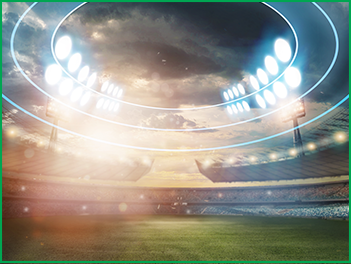
Sports lighting Design involves design calculations for the type of lighting to be used, number of poles, Array of luminaires, lux distribution etc. The purpose of the lighting is that it should create a comfortable and visually appealing environment for both players and spectators and for television broadcasting. Hence the design has to suit all these requirements.
The size and speed of play object plays a part in the lighting level required for that sport. As an example, cricket field requires higher lighting level because of the speed of play, small ball size and larger viewing distance. However a foot ball field required a lower light level, since the speed is slower, ball is bigger and play area is rectangle and smaller.
Our Sports lighting design services offered are as below : 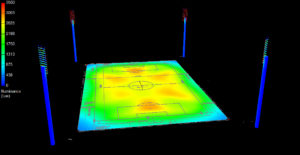
- Advise suitable standards as per the requirement
- Prepare lux calculations based on the Standards.
- Advise luminaire models selected, wattage and quantity.
- Produce the lighting layout drawing.
- Produce luminaire aiming details for flood light designs.
- Prepare luminaire specification for the designed Sports Field.
- Prepare the luminaire bracket layout for high masts.
Standards considered
- EN12193:2007(E)
- IESNA RP-6-01 -Recommended Practice for Sports and Recreational Area Lighting
- IESNA Handbook 10 th Edition
- International Tennis Federation Guide to Lighting Tennis Courts
- FIFA Lighting Standards for Football Stadiums
- UEFA Football Stadium lighting Guide
- SLL Lighting Handbook
- Abu Dhabi Lighting Manual – Issue-1: dated 14th February 2016,Part-2 Section-B – Sports Area Use Lighting-
- 4.3 Schedule of Lighting Levels
Types of Fields
3a Indoor Sports Halls & Fields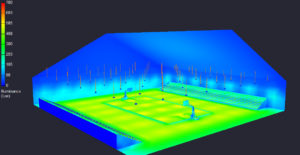
- Indoor Cricket Field
- Indoor Tennis Field
- Indoor Multipurpose Court
- Athletics
- Boxing
- Billiards
- Bowling
- Football
- Hockey
- Table Tennis
- Gymnastics
- Swimming
- Wrestling
Outdoor Sports Fields & Stadiums
- Football
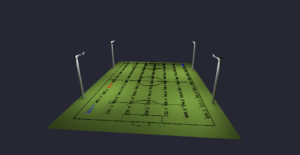
- Tennis
- Cricket
- Athletics
- Equestrian
- Volleyball & Basket Ball
- Hockey
- Go Cart Racing
- Swimming
- Cycle Racing
- Golf driving range
Our lighting srevices offered
Common lighting terms designed and measured in Sports Field
- Average Lux level is the average amount of light incident on playing surface.
- Uniformity level is the measure of the evenness of spread of light over the playing area.
- Uniformity level U1 is calculated as min lux level divided by Average lux level.
- Uniformity level U2 is calculated as Min lux level divided by Maximum Level.
- Vertical Illuminance is the amount of light on a vertical plane at the play area.
- Glare is the amount of disability glare to a person’s eye with the presence of lighting.
- Colour Rendering Index Ra is the ability of light source to render the colours naturally.
- Colour Temperature is the colour temperature of the light emitted by a light source.
- Uniformity Gradient is the Raito between lux levels at two adjacent measuring points.
Major considerations for designing a sports field
Lighting level required is different depending on the following main criteria:
- The sport
- Indoor / Outdoor
- Lighting Class of Play which can be based on:
- International Level or Televised
- National Level / Televised
- Regional Level / Televised
- Local Level
- Training
- Recreational.
Lighting Class Specification for Sports Events
Selection of lighting class as per EN12193:2007(E) is:
- International & National Level sports events come under Class I.
- Regional Level sports events come under Class I & II of EN12193:2007(E).
- Local Level tournaments fall under Class I,II & III.
- Training type of events come under Class II & III.
- Recreational and School Sports events are under Class III.
Lighting Levels as per Lighting specification EN12193 :2007(E) for Indoor sports
Lighting levels for Badminton, Cricket ,Hockey, Ice Hockey, Racket ball, Squash & Table Tennis
- For Class I events, – Horizontal Illuminance Eavg-750 lux/ U0 -0.7/Vertical Illuminance (Fence) -Evg-
- 500/U0-0.7/Horizontal Illuminance Cricket Net -Eavg-1500/U0-0.8
- Class II – Horizontal Illuminance Eavg-500 lux/ U0 -0.7/Vertical Illuminance (Fence) -Evg-300/U0-
- 0.7/Horizontal Illuminance Cricket Net -Eavg-1000/U-0.8
- Class III – Horizontal Illuminance Eavg-300 lux/ U0 -0.7/Vertical Illuminance (Fence) -Evg-200/U0-
- 0.7/Horizontal Illuminance Cricket Net -Eavg-750/U-0.8
Lighting levels for Basket ball, Football, Cycle Racing, GoCart, Handball, Volleyball, Weight Lifting, Wrestling etc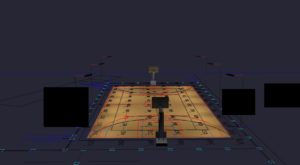
- Class I – Horizontal Illuminance Eavg-750 lux/ U0 -0.7
- Class II – Horizontal Illuminance Eavg-500 lux/ U0 -0.7
- Class III – Horizontal Illuminance Eavg-200 lux/ U0 -0.5
Lighting levels for Aerobics, Athletics, Dancing, Equestrian Jumping, Gymnastics, Skating etc.
- Class I – Horizontal Illuminance Eavg-500 lux/ U0 -0.7/Vertical Illuminance (Wall Climb) -Eavg-500 lux/ U0 -0.7
- Class II – Horizontal Illuminance Eavg-300 lux/ U0 -0.6/Vertical Illuminance (Wall Climb) -Eavg-300 lux/ U0 -0.6
- Class III – Horizontal Illuminance Eavg-200 lux/ U0 -0.5/Vertical Illuminance (Wall Climb) -Eavg-200 lux/ U0 -0.5
Lighting levels for Tennis Courts
- Class I – Horizontal Illuminance Eavg-750lux/ U0 -0.7
- Class II – Horizontal Illuminance Eavg-500lux/ U0 -0.7
- Class III – Horizontal Illuminance Eavg-300 lux/ U0 -0.5
Lighting Levels as per Lighting specification EN12193 :2007(E) for outdoor sports
Lighting Levels for Outdoor Tennis Courts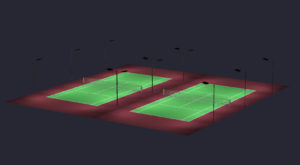
- Class I – Horizontal Illuminance Eavg-500lux/ U0 -0.7
- Class II – Horizontal Illuminance Eavg-300 lux/ U0 -0.7
- Class III – Horizontal Illuminance Eavg-200 lux/ U0 -0.6
Lighting Levels for Athletics, Equestrian
- Class I – Horizontal Illuminance Eavg-500lux/ U0 -0.7
- Class II – Horizontal Illuminance Eavg-200 lux/ U0 -0.7
- Class III – Horizontal Illuminance Eavg-200 lux/ U0 -0.6
Lighting Levels for Baseball, Cricket
Square Infield
- Class I – Horizontal Illuminance Eavg-750 lux/ U0 -0.7
- Class II – Horizontal Illuminance Eavg-500 lux/ U0 -0.7
- Class III – Horizontal Illuminance Eavg-300 lux/ U0 -0.5
Outfield
- Class I – Horizontal Illuminance Eavg-500 lux/ U0 -0.5
- Class II – Horizontal Illuminance Eavg-300 lux/ U0 -0.5
- Class III – Horizontal Illuminance Eavg-200 lux/ U0 -0.3
Lighting Levels for American football, Basketball, Fistball , Floorball, Football, Tug of War, Handball, Netball,
- Rugby, Volleyball, Beach Volleyball
- Class I – Horizontal Illuminance Eavg-500 lux/ U0 -0.7
- Class II – Horizontal Illuminance Eavg-200 lux/ U0 -0.6
- Class III – Horizontal Illuminance Eavg-75 lux/ U0 -0.5
Lighting Levels for Hockey
- Class I – Horizontal Illuminance Eavg-500 lux/ U0 -0.7
- Class II – Horizontal Illuminance Eavg-200 lux/ U0 -0.7
- Class III – Horizontal Illuminance Eavg-200 lux/ U0 -0.7
Lighting levels for the particular sport that is played has to be chosen and designed as per internationally and locally accepted standards.
The most common lighting standard referred in Europe for sports lighting is EN12193. In addition to that there are various national and internationally accepted standards generally for all sports activities . Other than that, sports organizations such as FIFA & ITF and other international sports authorities have their own internationally accepted standards which are widely used for national and international level of matches.
Uniformity of lighting level across the field is a major factor during the design. Too much difference in lighting levels at various points along the field will make a visual discomfort to players. Also this will affect spectators and television screening cameras. The uniformity is measured as both ratio of minimum to average and as minimum to maximum lighting levels.
A well designed lighting system is required for any indoor and outdoor sports facility because of the high precision required in light levels and uniformity. For Sports fields conducting televised events, light level and uniformity requirement is very high as per Internal Standards.
Due to the huge amount of light level required specially for televised and international level matches, the energy consumed is also very high. The luminaire design and optic chosen should be fair enough to optimise the luminaire quantity and energy. With a proper design, we can optimize the amount of luminaires, masts in the case of outdoor installations and minimize the amount of energy spent. Proper reliable third party software should be used for this high precision computing.
Like any other application, creating an appealing visual atmosphere using artificial lighting is required in Sports Fields. Poorly designed lighting with shadows and glare can cause fatigue and discomfort to both the players and spectators.
Luminaires should be aimed out of the direct view of players as it might cause glare while playing.
We have to select the light loss factor for the design according to the installation area and the periodic cleaning and maintenance cycle. We consider light loss factor during lighting design in order to account for the lighting deterioration over the period of use. So it will be possible to maintain the average illuminance for a particular period. For example consider the average lux level required is 100 lux and the installation time chosen is 100,000 hours. Then the sports field will have a maintained average of 100 lux or above for 100,000 hours starting from day 1.
Requirements of a well-designed sports lighting
A well-designed Sports lighting installation should comply the following:
- Illuminance Level as per Standards.
- Uniformity.
- Glare Control.
- Colour Rendering.
- Optimised Energy usage.
- Control of Shadows.
- Flicker Free .
- Control of Light Spill or Light Pollution to the surroundings and to the sky and should be within the specified limits.
- Visual Environment which is pleasurable for both players and spectators.
- Spill Light and light pollution Control for outdoor installations.
- Contrast
- Proper luminaire luminaire mounting height,arrangement, locations & Mast locations.
- Colour temperature between 4000 to 6500K.
LEDs have taken place of conventional light sources because of their low energy consumption, long life time and low maintenance costs. Specially for sports installations with high energy expenditure, minimizing energy consumption is a prime concern. For outdoor high mast installations, maintenance should be minimum and easily possible. Hence LED lighting has occupied first position over the years compared to other light sources. The only disadvantage of LED lighting is the high intitial cost. We have to make a payback analysis and decide upon .
You will have to consider the above advantages for calculating the payback period for LED Lighting. But the usage of conventional sources is already rare for new installations. Hence they may become obsolete very soon. Hence it is wise to use the LED technology and continuous upgradation is happening in LED luminaires. Most of the reputed manufacturers are not manufacturing conventional luminaires anymore. Unlike HID sources, LEDS are directional sources and light can be targeted to the required area without much light spill and wastage. LED light sources are instant on off devices without time delay. However HID sources have time delay before ON-OFF. Also it is easy to dim the LED sources easily. Dimming is possible for latest MH sources only. Dimming reduces life of MH sources and increases light loss. Glare is better controlled in HID sources than LED sources.
Spectator Area Lighting
Safety lighting for easy movement of spectators should be taken care. Proper emergency lighting as per local lighting standards should be made in case of power outages for providing safe atmosphere inside the stadium and also during evacuation of spectators.
Outdoor Sports Fields Recommendations
A well designed lighting is necessary for fast moving ball & player games like hockey and cricket.
The whole playing area should be lit evenly so that even the slightest of the movement is visible to both players, spectators and camera to the utmost clarity.The contrast between the players objects and surface should be well enough so that they are distinguishable.
For outdoor installations for high light levels required and higher uniformity requirement luminaires should be mounted on high masts to ensure that they are not tilted above 70 degree to minimise the glare produced.The high light output of luminaires for sports installtions will cause glare hence they should be fitted with glare control devices.Also the location of luminaires should be carefully chosen so that it doesnt directly hit the players and spectators view.
For sports applications requiring lighting above ground level and for televised events, vertical illuminance is also important and should be considered and designed for.
The lighting design should take care of optimising the initial buying cost of lighting system as well as the operating ( energy) and maintenance cost.
The luminaires should be carefully chosen from reputed manufacturers to minimise the energy cost and maintenance cost. For outdoor sports fileld luminaires on high masts the maintenance will be tedius and expensive. Hence the best luminaire quality and design should be chosen to avoid these to the minimum.
For football fields masts should not be positioned on the corners to avoid glare to goal keepers.
Periodic maintenance programme involving the cleaning of luminaires should be conducted for maintaining the performance of luminaires as in the design.
On site mainly for outdoor installations the luminaire aiming should be properly conducted as per the design . Slight variations in aiming may cause big difference in the actual lighting levels acheived on site.Aiming should also be verified from time to time which can vary due to strong wind and luminaire displacements.
Stray light or Light Pollution
The stray light from outdoor installation can cause disturbance to drivers on adjacent roads, nearby properties or users . Lighting system should be properly designed and aimed to control light spill as per the guidelines.
International Dark Sky Association (IDA) Recommendation for Outdoor Sports Lighting
To encourage the use of the best available technology for dark sky preservation, IDA
has established Criteria for Community-Friendly Outdoor Sports Lighting that upholds
the values that many communities seek in their public illuminated spaces. These criteria
ensure that outdoor sports lighting design minimizes obtrusive light spill and glare into
surrounding neighborhoods and natural areas, meets sustainability and climate-friendly
goals, and reduces sky glow to the greatest extent practicable. By utilizing IDA’s
criteria, communities demonstrate and promote the vision for outdoor sports lighting
that simultaneously meets the demanding task of illuminating night-time sports events
while preserving night skies
International Dark-Sky Association
IDA-Criteria for Community-Friendly Outdoor Lighting
Last updated: March, 2018
By adopting the IDA-Criteria for Community-Friendly Outdoor Sports Lighting,communities will:
- Minimize neighborhood lighting nuisance by greatly reducing spill and glare disruption.
- Manage high angle glare, thus dramatically decreasing off-site light trespass and sky glow.
- Mitigate neighborhood nuisance factors and sky glow which, in turn, provide
benefits to the environment, the astronomy community, and others. - Minimize lumen densities, which reduce energy consumption.(1)
Dimming & Control Of Luminaires
Lighting systems should be able to dim and controlled as per the latest standards and as per various light scenes required.
Indoor Sports Halls Recommendations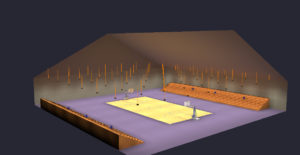
Indoor sports halls mainly are used for multiple sports . Multiple Switching arrangements can provide the necessary lighting level required for each sport.
Glare should be limited using well designed luminaires and choosing proper luminare locations and mounting.
For indoor sports halls the room surfaces should not be glossy and highly reflective.Matt reflection of walls can make the balls ,shuttle cocks etc highly visible and facilitate a glare free play area.
For tennis courts the luminaires should not be placed behind the base line to avoid glare to players.
Natural lighting can be considered for indoor sports facilites in a glare controlled manner. The will lead to energy saving and well being of the users of the space.
Swimming Pools Recommendations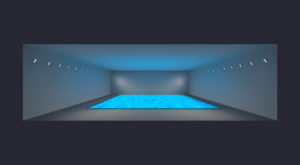
For swimming pools the lighting should cause minimum relection from the surface of water and thereby reduce glare. Glare should be reduced to the minimum for a visually appealing atmosphere to both players and spectators.The players and their movements should be visible to guards and spectators even under water.
For diving pools vertical illuminance should be considered while designing.
References
- https://www.darksky.org/wp-content/uploads/2018/03/IDA-Criteria-for-Community-Friendly-Outdoor-Sports-Lighting.pdf
- BS EN12193:2007(E) Light and lighting —Sports lighting
We offer our lighting design consultancy services across the world covering USA, Europe, UK, Africa and Middle East countries.
We offer our lighting design consultancy services across the Middle East covering United Arab Emirates, Kingdom of Saudi Arabia, Qatar, Oman, Bahrain, Kuwait, Iraq, Jordan, Lebanon, Egypt, Yemen etc.
